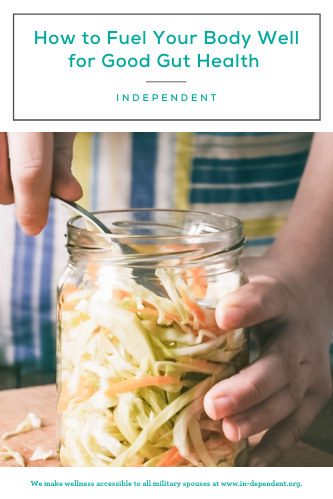One popular topic as of late is gut health, specifically in the context of probiotics and prebiotics.
Military spouses have to do a lot of research just to figure out day-to-day life when we’re new to an area. Figuring out the nuances of nutrition can be just one more thing that gets pushed to the bottom of the priority list. In an ever-changing environment of wellness and disease prevention, it can be hard to decipher what the newest information is, what to believe, and what is extra static adding to the barrage of noise. One popular topic as of late is gut health, specifically in the context of probiotics and prebiotics. So, let’s dive in and start with terminology.
What are probiotics and prebiotics?
According to the Food and Agriculture Organization and World Health Organization, probiotics are live microorganisms that enter our bodies through supplements or foods, and have beneficial effects on the health of the host after ingestion.
Prebiotics are not microorganisms at all, despite having a similar name. Instead, prebiotics are food components that are indigestible in our gut, but can promote the growth of desired probiotics in the microbiome.
In laymen’s terms, probiotics are tiny living things that might help our bodies after we ingest them, and prebiotics are the components of our food that help to feed the probiotics we are growing inside of our bodies.
How do probiotics help us?
While research is constantly changing in the health field, a few ideas are widely accepted when it comes to gut health and probiotics. Probiotics are regarded as “good bacteria” that work in conjunction with our immune system to fight “bad bacteria” in our bodies, as well as helping us digest food in our gut, and create vitamins for us. Probiotics are considered safe for the general, healthy population, but it’s always a good idea to speak with your health provider before adding a new supplement to your routine, especially if you’re considered a high-risk individual or immunocompromised. The most common bacteria strains of probiotics are Lactobacillus and Bifidobacterium, and Saccharomyces boulardii.
Where do we find probiotics and prebiotics?
Probiotics can be found in supplements or fermented/ cultured foods like sauerkraut and yogurt or cottage cheese. Good prebiotic sources are foods high in fiber like whole wheat flour, bananas, garlic, onions, and asparagus, to name a few. There are supplements available that contain probiotics, prebiotics, or both. If interested in adding supplements to your routine, be sure to speak with a registered dietitian or your primary health provider to identify what best works for you.
ABOUT HEATHER
Heather Campbell, Registered Dietitian
Heather is a registered dietitian, Air Force spouse, and mother of three. Her private practice, Glory Nutrition, focuses on helping overwhelmed women provide healthy family meals without spending hours in the kitchen. As an expert in educational speaking and a budding entrepreneur, she taught as adjunct faculty at Florida State University, presented for the USO, AFRC, and various private organizations. She has been quoted in Eat This, Not That, and is currently working with the Military Special Operations Collaboration and the Harvard Dinner Project to produce a cookbook for special operations families.
CONNECT WITH HEATHER














